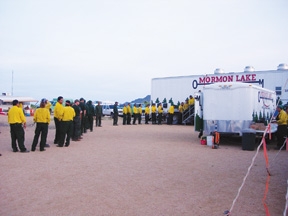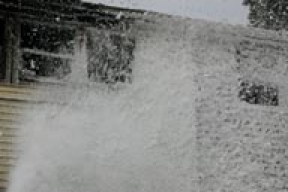 |
| Large diameter hose coupling slip occurred during pressurization. |
 |
| A FireCatt hose technician purges air from each discharge when at 45 psi, as directed by NFPA procedures. |
Fire hose is an essential weapon in a firefighter’s arsenal. Yet it can be a deadly accident waiting to happen if long-term wear and deterioration go undetected.
When a hose fails, the explosive force can send housings and couplings blasting through the air at speeds that can be fatal to anyone hit by the debris.
The best way to forestall such dangers is to regularly test fire hose in line with the National Fire Protection Association (NFPA) 1962 Standard for the Inspection, Care, and Use of Fire Hose, Couplings, and Nozzles and the Service Testing of Fire Hose. The standard calls for testing in-service hose at least annually. However, such tests must be done cautiously and with the correct preparation, warns NFPA Fire Hose Committee Chair Carl Peterson.
“Before you test a hose, you have to inspect it to ensure that there is no fraying or other signs of imminent failure,” he said. “You then have to make sure that the hose is properly secured to keep it from thrashing about if something does give. You also have to make sure that the pressure measurement equipment is accurate and robust and that the platform you are using for delivering pressure up to 400 psi can handle the strain.”
Peterson noted that pumpers are not designed to withstand such static pressure tests. “They are built to flow water, not let it stand still and build up pressure,” he said. “If you are going to test hoses safely without damaging your field equipment, you need dedicated hose-testing equipment.”
Pressurized hose testing can be a risky exercise for any fire department, and private companies that provide hose-testing services are expanding.
A case in point is Seminole Fire Rescue in Florida. “One of our firefighters was severely injured in 2009, when a hose came apart during testing and struck him in the head,” recalled Seminole Division Chief of Operations Michael Johansmeyer.
As a result of that accident, he said his department decided to outsource its testing to Fire CATT, a company established in Troy, Mich., in 2007 by people associated with Snap-Tite, a fire hose product manufacturing company. Fire CATT is short for “Fire Critical Asset Testing and Tracking.”
“They brought their hose testing trailer to our site, and tested about 100,000 feet of hose safely,” Johansmeyer said. “They also recorded the results of each hose test, storing it electronically so that we could add it to our database and clearly labeled any hoses that failed.”
In Texas, the Sugar Land Fire Department hired Fire CATT to test 34,304 feet of fire hose on-site. “They did the work in just three days,” said SLFD Logistics Capt. Brian Holcombe. “The tests were consistent, scientific and properly documented. We were happy not to have to use our personnel or equipment – neither of which are primarily tasked for hose testing, and we were very glad to discover that less than 1 percent of our hose had to be replaced.”
Allan Sperle, a former assistant fire chief and a Fire CATT sales representative who serves as the company’s spokesperson, said the company was created “to engineer an accurate, safe, efficient and technology-driven hose testing system.”
The Fire CATT platform is built into its trailer, which incorporates manifold connections for up to 10 fire hoses plus a relief valve. The amount of pressure delivered to each manifold, the water delivery time and other critical factors are computer-controlled and recorded inside the trailer, where Fire CATT’s engineers perform the tests in safety.
“We have the ability to set different pressures on each of the manifolds,” Sperle said. “This allows us to move through testing relatively quickly, up to 12,000 feet of hose per day. Meanwhile, the records we generate give our clients clearly documented results on every single length of hose. And whether a section passes or fails, it is clearly tagged after the test so that the client knows what to keep and what to dispose of.”
Fire CATT’s reports can be filed at the client’s headquarters for ISO audits. “You also have access to our Web site to access your report for inventory sorting, identification and publishing by report category,” Sperle said. “Our reports can be exported and utilized in Fire House and other fire department software programs.”
Fire hose testing has its challenges.
“NFPA 1962 provides a robust process for testing hose,” Sperle said. “However, there are conflicts within its process due to the lack of capable equipment available on the market.”
One problem, he said, relates to NFPA’s requirement for pressure increases to not exceed 15 psi per second, which can be difficult to achieve if a department is increasing pressure manually. He said Fire CATT’s system uses digital pressure transducers in its manifold, so that changes are automatically controlled and limited by the system’s software.
A second hose testing issue relates to human reaction time: If the hose suddenly ruptures under pressure, how fast can someone shut down the pressure? Even if the tester could shut off the flow of water instantaneously, the existing water pressure inside the hose will still cause it to release explosively – and potentially whip around, injuring anyone in its path.
“The Fire CATT system is designed to shut off water flow within one-quarter of a second if it senses a pressure drop during pressurization,” Sperle said. “Shutting off the water flow via a comprehensive valve system allows Fire CATT to eliminate this risk and thus eliminate injury to the hose testers.”
A third conundrum is NFPA 1962’s requirement for the operator to open a bleeder valve on the test cap to release pressure, following a hose test. The problem is that this same operator is not supposed to be standing near the hose when it is under pressure.
Sperle put it this way: “If one is to follow the first part of the process then how can one follow the next part of the process? That is, stay away during testing, but then approach the hose and open a valve to relieve pressure?”
Officials at three departments that have used Fire CATT’s hose testing service give the company high marks.
Sugar Land Fire Department officials said they chose Fire CATT to save wear and tear on their pumpers, and to minimize risk to their staff. “Fire CATT got the job after responding to our RFP,” Capt. Holcombe said. “There were only three weeks between when we gave them the job and they came to our premises. Fire CATT”s people were professional and very accommodating to our needs. I would not hesitate to recommend them to other fire departments.”
Fire Chief Doug Halstead of the Burton (Mich.) Fire Department said Fire CATT was selected because of its technology and its ability to create trackable records that could be incorporated into his department’s database.
“They also gave us the choice of doing the tests with their equipment using our people, their people, or the two teams combined,” he said. “This allowed us the option of choosing the most affordable method for our budget.”
In Seminole County, Johansmeyer said Fire CATT met the requirements of the department’s request for proposals (RFP) in a professional, consistent manner.
“I am always looking for quality and integrity in any vendor that we select,” he said. “Fire CATT measures up to this standard. They do good work and are open, honest and fair-priced. And if they can’t do what you want for the price you can afford, they tell you up-front. There are no games.”
Fire CATT said its client base has doubled every year it has been in business.
“We are serious about safe, standardized and measurable fire hose testing,” said Allan Sperle. “This is why Fire CATT was established, and it drives everything that we do today.”
Safe Alternatives
Here is a list of companies that provide fire hose testing services and equipment:
Access Hose & Ladder Company: www.axcesshose.com/fire-hose-testing-services.html
Fail Safe Testing: www.failsafeusa.com
FireOne: www.fire-one.com
National Fire Equipment: www.nationalfire.com
National Hose Testing Specialities: www.nhts.com
Niedner: www.niedner.com/en/fire-hose-testing.aspx
North Florida Host Testing Services: www.firehosetester.com
SafetyFirstFireHose: www.safetyfirstfirehose.com
Saskatoon Fire Protection: www.saskatoonfire.com
Waterway Fire Host Testing: www.waterwayinc.com
More Fire Apparatus Current Issue Articles
More Fire Apparatus Archives Issue Articles

